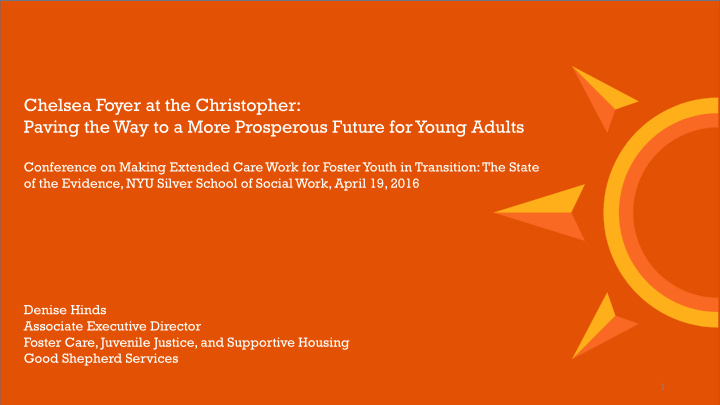



Chelsea Foyer at the Christopher: Paving the Way to a More Prosperous Future for Young Adults Conference on Making Extended Care Work for Foster Youth in Transition: The State of the Evidence, NYU Silver School of Social Work, April 19, 2016 Denise Hinds Associate Executive Director Foster Care, Juvenile Justice, and Supportive Housing Good Shepherd Services 1
Mission Good Shepherd Services goes where children, youth, and families face the greatest challenges and builds on their strengths to help them gain skills for success. We provide quality, effective services that deepen connections between family members, within schools, and among neighbors. We work closely with community leaders to advocate, both locally and nationally, on behalf of our participants to make New York City a better place to live and work. Good Shepherd Services leads in the development of innovative programs that make a difference in the lives of children, youth and families today. 2
What we do A multi-service agency, we operate networks of community-based youth development, education, and family service programs in Brooklyn and the Bronx; group homes for adolescents; foster care and adoption services; and an in-service professional training program. Last year alone: 33, 643 participants were served through 88 programs operated across 3 boroughs (Brooklyn, Bronx, Manhattan) 3
Chelsea Foyer at the Christopher • Opened in 2004. Based on Foyer model developed in the UK. • Provides supported transitional housing to 40 homeless, runaway, and former foster care youth, ages 18-25. • Residents participate in a personalized program of services for up to 24 months. • Program design incorporates Good Shepherd’s Youth and Family Development Approach, The Sanctuary Model, and the WORC. 4
Who we serve Average Age at Admission 21 Referral Source Emergency Shelter 47% Gender Foster Care 28% Male 40% Community-Based Organization 3% Female 58% Transitional Program 13% Transgender 1% Mentor 1% Self-Referral 4% Race/Ethnicity Family or Friend 4% African American/African/Black Foster Care History 61% Yes 36% Latino/Hispanic 33% No 64% White/Caucasian 3% Inter-Racial 3% Mental Health Concerns Participants reporting at least one traumatic event (UCLA PTSD scale) 92% Participants reaching clinical cutoff on one or more Trauma Symptom 45% Inventory (TSI) scales 5
Program model Key Program Components On-Site Support Services o Case Management Services o Rigorous Application Process o Life-Skills Development o Contract/Lease and Action Plan o Educational/Employment o Limited Structure/High Expectations Resources o On-Site Support Services o Community Building o Program Fee/Rent o Housing and Aftercare Services o Workforce Development Culture 6
Funding Landscape • There is NO dedicated funding stream for the Chelsea Foyer. • To operate both programs, each year Good Shepherd pieces together funding from a number of sources including grants from Federal, State, and City agencies, as well as private contributions from foundations, corporations and individuals . Public Funders Private Funders Tiger Housing and Urban Development Robin Hood NYS Supportive Housing Program Barclays Dept of Health and Mental Hygiene Conrad Hilton Dept of Youth and Community Development Dept of Homeless Services 7
Program performance At exit 12+ Months Stable Housing 82% 95% Employed 79% 95% Supportive Network 97% N/A Results are for FY15. Chelsea Foyer had 72 participants with 39 exits and 23 alumni surveyed. Survey response rate 50%. 8
The City of New York Office of the Deputy Mayor for Health and Human Services Chelsea Foyer at the Christopher Supportive Housing Program: Outcomes Study In partnership with: Funded by: Larson Family Foundation 9
Evaluation Logic Model Insert revised version from new brief 10 10
Demographics of Sample Comparison Chelsea Foyer Total Group: Participants (n=297) Unplaced NY3 (n=138) (n=159) Mean age in years (SD) 20.5 20.4 Gender 41% 42% 40% Male Female 59% 58% 60% Race/Ethnicity African American/Black 63% 64% 62% Caucasian/White 4% 3% 5% Hispanic 29% 31% 27% Asian/Other 4% 2% 6% High school graduate 56% 59% 53% 11 11
Administrative Data Outcomes were measured by matching program data with NYC administrative data • Administration for Children’s Services (ACS): Foster care spells • Human Resources Administration (HRA): Cash Assistance and SNAP benefit receipt, Medicaid expenses, SSI status • Department of Homeless Services (DHS): Stays in single adult homeless shelters and family shelters • Department of Correction (DOC): Jail stays Analysis: Modified poisson regression to calculate relative risk of service use 12 12
Key Findings Within the two years after entry: • participants were 36% less likely than the comparison group to have a stay in a single adult shelter. • participants were 55% less likely than the comparison group to go to jail. • the percentage of participants who were employed increased to 91%. • the percentage of participants who were enrolled in college increased to 40%. 13 13
Policy Implications Lower rates of homeless shelter stays and jail stays for Foyer participants point to the benefits of expanding this program model Main stream funding designed to finance model through city, state and federal agreements The use of administrative outcome data can be used to determine well-being of a population after leaving care as a measure of programs and city agency performance 14 14
National Implications Provides evidence that the Foyer model was beneficial for a broader at risk group than previously defined: • Youth aging out of foster care • Youth who are homeless, such as those in emergency shelters • Youth who are at risk of becoming homeless, such as those referred from the community • Youth who have had previous system involvement Policy and funding mechanisms should reflect this new definition of at-risk youth who can benefit from supportive housing: • Possible Pilot for Performance Partnership Pilot (US HHS) • Expand HUD definition of RWY and Homeless Youth 15 15
Recommend
More recommend